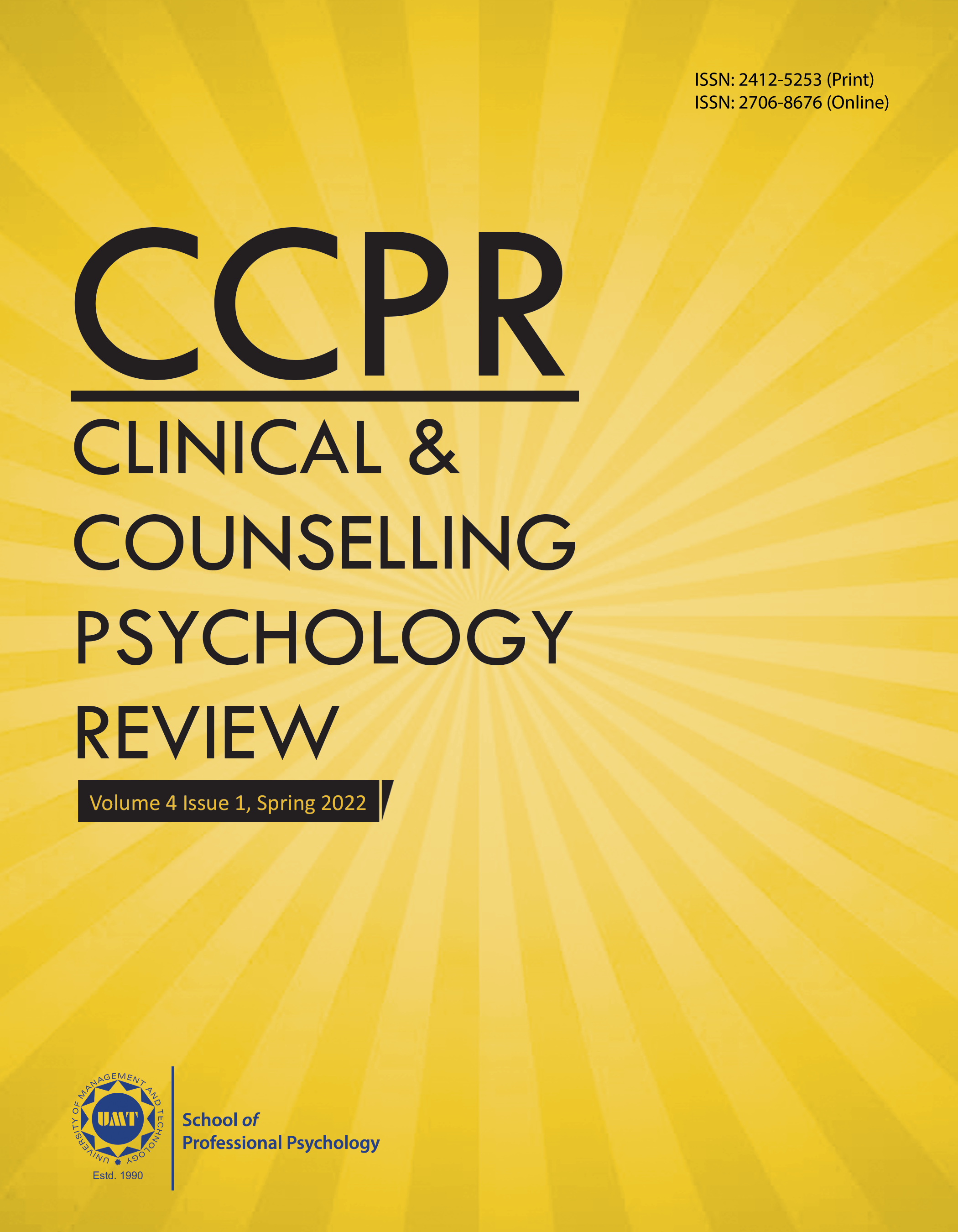Predicting the Role of Emotional and Behavioral Problems on Delinquent Tendencies in Adolescents
Abstract
 Abstract Views: 216
Abstract Views: 216
The current study aims to investigate the relationship between emotional and behavioral problems and delinquent tendencies in adolescents. It was hypothesized that there is a significant relationship between emotional and behavioral problem with delinquent tendencies in adolescents. Purposive convenient sampling was used to select the 225 participants between the ages 12-19 years. The participants were selected from private and government institutes in Karachi city. Emotional and behavioral problems were measured through indigenously developed scale School Children Problem Scale SCPS (Saleem & Mahmood, 2011), whereas Delinquent tendencies were assessed using the Self-Report Delinquency Scale SRDS (Irum Naqvi & Anila Kamal, 2008). A Pearson correlation analysis showed that a significant moderate relationship exists between emotional and behavioral problems and delinquent tendencies in adolescents. Further suggestion and implications for future researches were also discussed.
Downloads
References
Achenbach, T. M., & Edelbrock, C. S. (1978). The classification of child psychopathology: A review and analysis of empirical efforts. Psychological Bulletin, 85(6), 1275–1301. https://doi.org/10.1037/0033-2909.85.6.1275
Ahmed, U., & Murtaza, A. (2016). Factors affecting juvenile delinquency in Punjab, Pakistan: A case study conducted at juvenile prisons in Punjab province. Mediterranean Journal of Social Sciences. https://doi.org/10.5901/MJSS.2016.V7N4P372
Alamgir, M., Wajid, R., & Ali, Muhammad Zeeshan. (2022). Explore the factors behind Juvenile delinquency in Pakistan. A research conducted in juvenile jail of Rawalpindi Pakistan. International Journal of Scientific & Engineering Research, 9(3), 1086-1091.
American Psychiatric Association (2013). Diagnostic and Statistical Manual of Mental Disorders (5th ed.). American Psychiatric Publishing.
Arnett, J. J. (1999). Adolescent storm and stress, reconsidered. American Psychologist, 54(5), 317-326. https://doi.org/10.1037//0003-066X.54.5.317
Baker, J. A., Grant, S., & Morlock, L. (2008). The teacher-student relationship as a developmental context for children with internalizing or externalizing behavior problems. School Psychology Quarterly, 23(1), 3-15.
Baldry, A. & Farrington, D. (2000). Ullies and delinquents: Personal characteristics and parental styles. Journal of Community and Applied Social Psychology. 10. 17-31. https://doi.org/10.1002/(SICI)1099-1298(200001/02)10:13.0.CO;2-M
Bandura. (1977). Social Learning Theories - Social Learning Theories. Prentice Hall
Banovcinova, A., Levicka, J., & Veres, M. (2014). The impact of poverty on the family system functioning. Procedia - Social and Behavioral Sciences, 132, 148–153. https://doi.org/10.1016/J.SBSPRO.2014.04.291
Barnow, S., Lucht, M., & Freyberger, H. J. (2005). Correlates of aggressive and delinquent conduct problems in adolescence. Aggressive Behavior, 31(1), 24–39. https://doi.org/10.1002/AB.20033
Bjelland, I., Krokstad, S., Mykletun, A., Dahl, A. A., Tell, G. S., & Tambs, K. (2008). Does a higher educational level protect against anxiety and depression? The HUNT study. Social Science & Medicine, 66(6), 1334-1345.
Cairns, R. B., & Cairns, B. D. (1994). Lifelines and risks. Harvester Wheatsheaf.
Cicetti, F. (2010). Anxiety may increase with age. https://www.livescience.com/8452-anxiety-increase-age.html
Dhuria, M., Sharma, N., Taneja, D. K., Kumar, R., & Ingle, G. K. (2009). Assessment of mental health status of senior secondary school children in Delhi. Asia-Pacific Journal of Public Health, 21(1), 19–25. https://doi.org/10.1177/1010539508327031
Elgar, F. J., Knight, J., Worrall, G. J., & Sherman, G. (2003). Behavioural and substance use problems in rural and urban delinquent youths. Canadian Journal of Psychiatry, 48(9), 633–636. https://doi.org/10.1177/070674370304800911
Erikson, E. H. (1950). Growth and crises of the “healthy personality”. In M. J. E. Senn (Ed.), Symposium on the healthy personality (pp. 91–146). Josiah Macy, Jr. Foundation.
Erikson, E. H. (1968). Identity, youth, and crisis. W. W. Norton.
Goldenson, J. (2015, June 16-18). Adverse Childhood Experience (ACES) and Juvenile Delinquency: An Examination of 100 Incarcerated Adolescents [Paper presentation]. 15th Annual Conference of the International Association of Forensic Mental Health Services (IAFMHS), Manchester, UK.
Gottfredson, G. D. (2011). Schools and Delinquency. In D. M. Bishop, B. C. Feld (Eds.), The oxford handbook of juvenile crime and juvenile justice (pp. 203-225). Oxford Academics. https://doi.org/10.1093/OXFORDHB/9780195385106.013.0009
Graham, S., & Juvonen, J. (1998). Self-blame and peer victimization in middle school: an attributional analysis. Developmental Psychology, 34(3), 587–538. https://doi.org/10.1037//0012-1649.34.3.587
Green, D. (2005). The underlying causes of juvenile crime. Civitas. http://www.civitas.org.uk/blog/2005/01/the_underlying_causes_of_juven.html
Guarnotta, E. (2020). How is age related to anxiety? https://www.goodrx.com/conditions/generalized-anxiety-disorder/how-is-age-related-to-anxiety
Hirschi, T. (1969) Causes of delinquency. University of California Press.
Honkatukia, P. & Kivivuori, J. (2006). Juvenile crime in Finland: Trends, causes, and control. Ulosottolaitos. http://www.optula.om.fi/Satellite?
Idea. (2017). Sec. 300.8 (c) (4). Idea. https://sites.ed.gov/idea/regs/b/a/300.8/c/4
Jogdand, S., & Naik, J. (2014). Study of family factors in association with behavior problems amongst children of 6-18 years’ age group. International Journal of Applied and Basic Medical Research, 4(2), 86. https://doi.org/10.4103/2229-516X.136783
Khurshid, F., & Urooj, T. (2012). Causes of juvenile delinquency among teenagers in Pakistani context. Elixir Criminal Law, 45, 7793-7796.
Kuther, & Tara L. (1995). Adolescents At-Risk: A literature review of problems, attitudes, and interventions (Publication No. ED 386644) [Master thesis, Fordham University]. ERIC. https://files.eric.ed.gov/fulltext/ED386644.pdf
Lerner, R. M., & Steinberg, L. (2004). Handbook of Adolescent Psychology, Second Edition. John Wiley & Sons.
Mahmood, K., & Cheema, M. A. (2004). Pakistan journal of life and social sciences empirical analysis of juvenile crime in Punjab, Pakistan. Pakistan Journal of Life and Social Science, 2(2), 136–138.
McLeod, S. (2017). Bowlby's Attachment Theory. Simply Psychology. https://www.simplypsychology.org/bowlby.html
Mental Health Foundation. (2022, July 24) Children and young people: Statistics. Mental Health Foundation. https://www.mentalhealth.org.uk/explore-mental-health/statistics/children-young-people-statistics
Merrell, K. W. (2008). Helping students overcome depression and anxiety: A practical guide (2nd ed.). Guilford Press.
Merrell, K. W. (2003). Behavioral, social, and emotional assessment of children and adolescents. Lawrence Erlbaum Associates Publishers.
Mubashir, Z. (2017). Rural-Urbanization in Pakistan. LinkedIn. https://www.linkedin.com/pulse/rural-urbanization-pakistan-zahid-mubashir
My Legal Rights. (2022, February 8). Role of juvenile justice system in Pakistan. My Legal Rights. https://www.mylegalrights.com.pk/2022/02/role-of-juvenile-justice-system-in.html
Naqvi, I., & Kamal, A. (2008). Development of Self-Reported and Informant Reported Delinquency Scales for Laborer Adolescents. FWU Journal of Social Sciences, 1(2), 60-84.
Pathak, R., Sharma, R. C., Parvan, U. C., Gupta, B. P., Ojha, R. K., & Goel, N. K. (2011). Behavioural and emotional problems in school going adolescents. Australasian Medical Journal, 4(1), 15–21. https://doi.org/10.4066/AMJ.2011.464
Rafique, A. (2017, September 15). Juvenile delinquency in Pakistan. Daily Times. https://dailytimes.com.pk/116851/juvenile-delinquency-in-pakistan/
Rucevic, S., Ajdukovic, M. & Sincek, D. (2009). Development of youth self-reported delinquency and risk behaviors questionnaire. Kriminologija & Socijalna Integracija,17(1). https://hrcak.srce.hr/40729
Rumberger, R. W. (1995). Dropping out of middle school: a multilevel analysis of students and schools. American Educational Research Journal, 32(3), 583–625. https://doi.org/10.3102/00028312032003583
Saleem, S. & Mahmood, Z. (2011). Development of a scale for assessing emotional and behavioral problems of school children. Pakistan Journal of Social and Clinical Psychology, 9, 73-78.
S-Cool. (2022, July 25). Media influences on pro- and anti-social behavior. S-cool. https://www.s-cool.co.uk/a-level/psychology/pro-and-anti-social-behaviour/revise-it/media-influences-on-pro-and-anti-social-b
Shahzad, S., & Yasmin, S. (2015). Aggression as risk for delinquency and substance abuse in adolescents. International Journal of Prevention and Treatment of Substance Use Disorders, 1(3-4), 106-118.
Syed, E. U., Hussein, S. A., & Haidry, S. E. Z. (2009). Prevalence of emotional and behavioural problems among primary school children in Karachi, Pakistan - Multi informant survey. Indian Journal of Pediatrics, 76(6), 623–627. https://doi.org/10.1007/S12098-009-0072-7
Syed, E. U., Hussein, S. A., & Mahmud, S. (2007). Screening for emotional and behavioural problems amongst 5-11-year-old school children in Karachi, Pakistan. Social Psychiatry and Psychiatric Epidemiology, 42(5), 421–427. https://doi.org/10.1007/S00127-007-0188-X
The Editors of Encyclopaedia Britannica (2022, July 24). Delinquency: Criminology. Britannica. https://www.britannica.com/topic/delinquency
Windle, M., & Mason, W. A. (2016). General and specific predictors of behavioral and emotional problems among adolescents. Journal of Emotional and Behavioral Disorders, 12(1), 49–61. https://doi.org/10.1177/10634266040120010601
World Health Organization. (2022). Adolescent health. WHO. https://www.who.int/health-topics/adolescent-health#tab=tab_1
World Youth Report. (2003). Chaper 7: Juvenile delinquency. https://www.un.org/esa/socdev/unyin/documents/ch07.pdf
Zafar, M. (2012). Causes of Juvenile Delinquency among Teenagers in Pakistani Context. Law, Article e154812615. https://www.semanticscholar.org/paper/Causes-of-Juvenile-Delinquency-among-Teenagers-in-Zafar/c233425958fec06ab55086cf5c6f4e4976fde509
Zahn-Waxler, C., Klimes-Dougan, B., & Slattery, M. J. (2000). Internalizing problems of childhood and adolescence: Prospects, pitfalls, and progress in understanding the development of anxiety and depression. Development and Psychopathology, 12(3), 443–466. https://doi.org/10.1017/S0954579400003102
Zulu. (2019). Pakistan’s biggest crisis: Human resource. Pakistan Defence. https://defence.pk/pdf/threads/pakistans-biggest-crisis-human-resource.622235/








